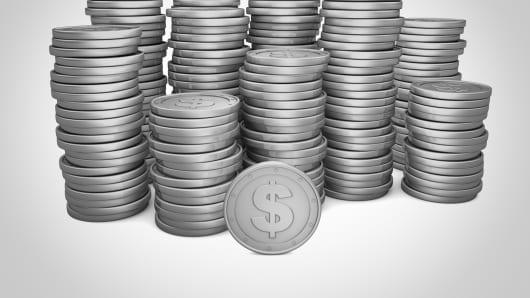The provision of the law which is relied upon by advocates of minting a trillion coin was passed to allow the U.S. Mint to sell platinum coins to collectors and to people who want to accumulate platinum bullion. Selling platinum coins in the U.S. and Japanese markets had been dominated by the Japanese until the U.S. Mint got involved. Very quickly, the U.S. Mint had 80 percent of the market.
The U.S. Treasury makes money from these coin sales because the coins are sold for more than the cost of producing them. Like almost all high-denomination modern currencies, the face values are greater than the value of the underlying materials. A one-hundred-dollar bill has nowhere near that level of cotton, flax or ink in it.
What the trillion-dollar coin advocates want to do is use the Treasury's authority to make platinum coins as a way of nullifying Congress's authority on the debt ceiling. The idea is to mint a trillion coin and deposit this with the Federal Reserve, which would then allow the Treasury to employ this trillion to pay for already-authorized spending without issuing new bonds or raising taxes.
That's a very different use for the coin than anything anticipated by the framers of the platinum coin law. Legally, this may or may not matter. For one thing, the federal courts would likely be loathe to get involved in a budget dispute between the House of Representatives and the White House. The courts would likely seek some way out of making any decision at all. For another, lots of laws are used for purposes that no framers would ever have imagined. Federal racketeering statutes—originally aimed at organized crime—are now regularly used to pursue non-violent business crimes, for example.
Nonetheless, congressmen could certainly object that this is an abuse of the law—and they'd be right. This just isn't what the law is for. The trillion-dollar coiners would be taking advantage of a drafting error.
Ip raises the argument that this would also jeopardize Fed independence. The Treasury would basically be ordering the Fed to implement a new monetary policy.
We have a central bank to separate fiscal from monetary policy. The Fed implements QE when it has decided that's the best way to carry out its monetary policy objectives. Buying a coin solely to finance the deficit is monetizing the debt, precisely the sort of thing central bank independence was meant to prevent. How could any Federal Reserve chairman justify cooperating in such a scheme, in particular since the Fed would be taking the White House's side in a fight with Congress over a matter of dubious legality?
Ip's solution is to have the coin sold to the public rather than deposited to the Fed. Here's how he explains this idea:
There is a way around this problem that preserves the Fed's independence. That would be for the Treasury to issue the coin to the public, instead of the Fed, thereby leaving the Fed's balance sheet, and its control of monetary policy, alone. Of course, no one would want a $1 trillion coin. But Gary Gorton, an economist at Yale University, suggests there might be demand for a bunch of $50 million coins. He notes the financial system still craves safe, liquid assets. Corporations in particular are desperate for a safe place to park cash now that unlimited federal deposit insurance has expired. Including fees, many bank accounts now sport negative yields, as at times do Treasury bills. Money-market mutual funds may float their asset values. Platinum coins would represent a risk-free, liquid way to store cash with no risk of negative yields.
Of course, if the CFO lost one down a sewer grate, it would be a disaster. So instead, the Fed could simply keep the coins in a vault with their owners' names affixed. When one owner wants to settle payments with another, the Fed could simply switch labels. In the meantime, Treasury gets the equivalent of an interest-free loan from the public and a reprieve from the debt ceiling. Not quite a free lunch, but close enough.
This goes a long way to avoiding the legal problem I was discussing above. Here, the minting authority of the Treasury Secretary would be used in a way much closer to what was imagined by the authors of the law: selling coins to the public. The spending power generated by minting the coin would come from actual coin purchases, which is also what was anticipated by the law's authors. The only difference is that the revenues would be much higher than anyone expected.
I think this also gets rid of some of the weirdness problem that has always plagued the mint the coin idea. People just aren't comfortable with the idea that the Treasury can create spending power out of thin air by depositing a newly minted coin at the Fed. Here the Treasury's spending power would arise from actual revenue from the sale of a coin, just like it does when the Treasury sells a bond.
Instead of #mintthecoin, we should mint the coins. And then sell them.





